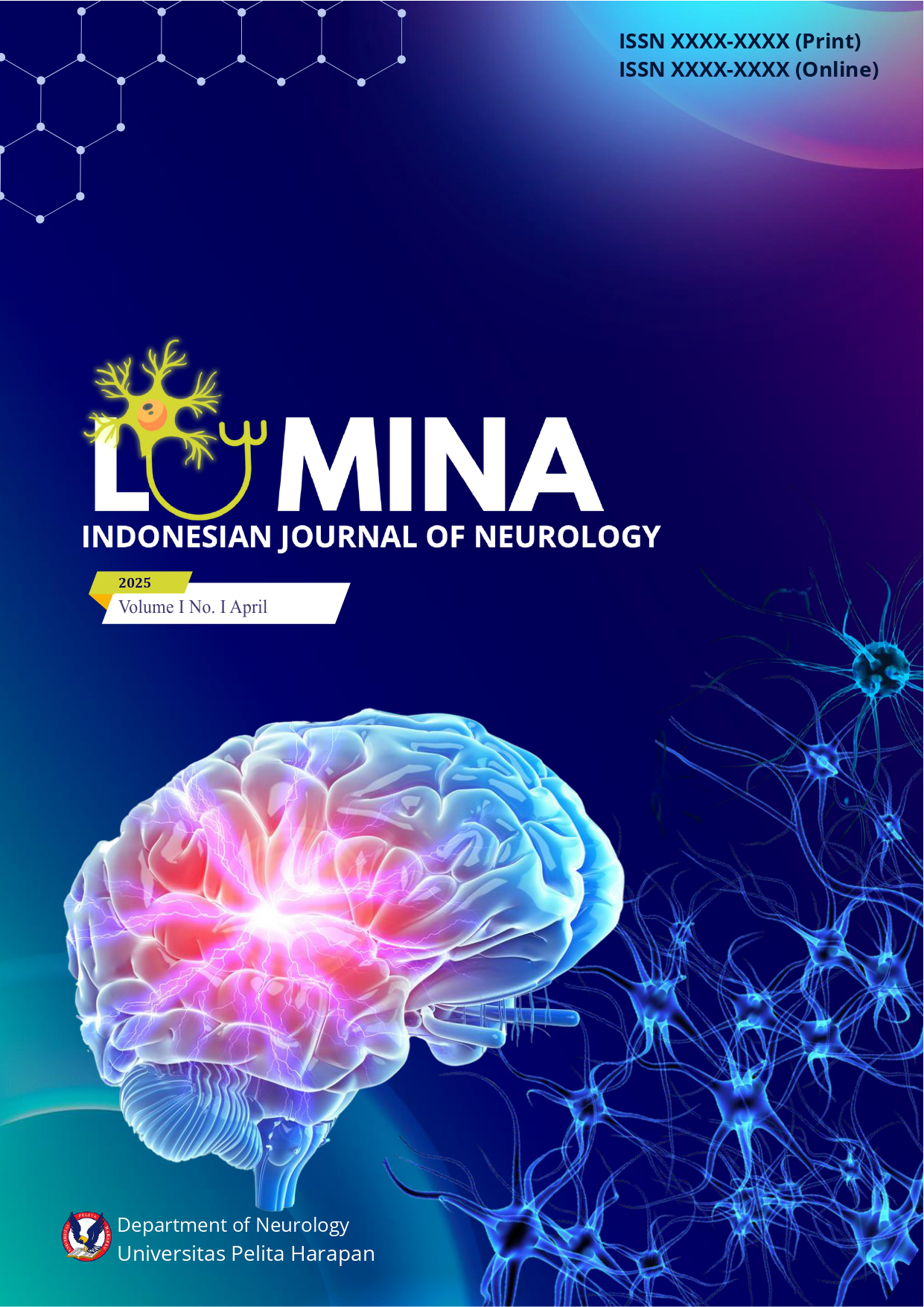Postictal Fugue in Temporal Lobe Epilepsy: A Case Report
DOI:
https://doi.org/10.19166/lijn.v1i1.9860Keywords:
Postictal fugue, Temporal lobe epilepsy, Organic dissociative disorderAbstract
Introduction: Temporal lobe epilepsy (TLE) is the most prevalent form of epilepsy. Postictal fugue, a state of altered consciousness and amnesia that can lead to unusual behaviors, is an unusual type of postictal phase in TLE. This case report describes a rare case of postictal fugue in adult-onset TLE.
Case Report: A 27-year-old man with complaints of recurrent seizures over the past six years, described as blank staring accompanied by purposeless action with each episode lasting 5-10 minutes on average. During the episodes, he can perform various activities without the ability to recall the events after regaining consciousness. There were neither aura nor specific triggers preceding the episodes. Some long-term memories are impaired. No other cognitive impairment is found. There was a long-standing history of substance use. Electroencephalogram examinations revealed abnormal spikes wave in bilateral temporal region.
Discussion: The patient’s symptoms resemble dissociative fugue but is attributed to an organic etiology, which is mesial/limbic TLE. The postictal phase which manifests as postictal fugue is caused by the abnormal electrical activity in the hippocampus leading to disruption in memory formation and spatial navigation. The underlying mechanism causing epilepsy is thought to be related to the prolonged history of substance abuse.
Conclusion: The postictal phase in TLE can present in various forms and may be challenging to diagnose. Therefore, it is crucial to thoroughly investigate the causes of organic dissociative disorder, including postictal fugue in TLE.
References
1. M cIntosh WC, Das JM. Temporal Seizure. StatPearls [Internet]. 2025. https://www.ncbi.nlm.nih.gov/books/NBK549852/
2. Abood W, Bandyopadhyay S. Postictal Seizure State. StatPearls [Internet]. 2025. https://www.ncbi.nlm.nih.gov/books/NBK526004/
3. Khwaja GA, Duggal A, Kulkarni A, Chaudhry N, Gupta M, Chowdhury D, et al. Recurrent prolonged fugue states as the sole manifestation of epileptic seizures. Ann Indian Acad Neurol. 2013;16(4):561–564. https://doi.org/10.4103/0972-2327.120468
4. Fisher RS, Acevedo C, Arzimanoglou A, Bogacz A, Cross JH, Elger CE, et al. ILAE Official Report: A practical clinical definition of epilepsy. Epilepsia. 2014;55(4):475–82. https://doi.org/10.1111/epi.12550
5. American Psychiatric Association. Diagnostic and Statistical Manual of Mental Disorders Fifth Edition Text Revision. 5th ed. Washington DC: American Psychiatric Association; 2022.
6. World Health Organization. The ICD-10 Classification of Mental and Behavioural Disorders. 10th ed. Geneva: WHO Library Cataloguing in Publication Data; 1992.
7. Victor TR, Tsirka SE. Microglial contributions to aberrant neurogenesis and pathophysiology of epilepsy. Neuroimmunol Neuroinflamm. 2020; 7: 234-247. https://doi.org/10.20517/2347-8659.2020.02
8. Henning O, Heuser K, Stangeby V, Sen LA. Temporal lobe epilepsy. Tidsskr Nor Laegeforen. 2023; 143(2). https://doi.org/10.4045/tidsskr.22.0369
9. Vinti V, Dell’Isola GB, Tascini G, Mencaroni E, Cara G Di, Striano P, et al. Temporal Lobe Epilepsy and Psychiatric Comorbidity. Vol. 12, Frontiers in Neurology. Frontiers Media S.A.; 2021. https://doi.org/10.3389/fneur.2021.775781
10. Caciagli L, Paquola C, He X, Vollmar C, Centeno M, Wandschneider B, et al. Disorganization of language and working memory systems in frontal versus temporal lobe epilepsy. Brain. 2023; 146(3):935–53. https://doi.org/10.1093/brain/awac150
11. Torrico TJ, Abdijadid S. Neuroanatomy, Limbic System. StatPearls [Internet]. 2025. https://www.ncbi.nlm.nih.gov/books/NBK538491/
12. Mujawar S, Patil J, Chaudhari B, Saldanha D. Memory: Neurobiological mechanisms and assessment. Ind Psychiatry J. 2021; 30(Suppl1):S311-S314. https://doi.org/10.4103/0972-6748.328839
13. Raslau FD, Klein AP, Ulmer JL, Mathews V, Mark LP. Memory Part 1: Overview. American Journal of Neuroradiology. 2014; 35(11):2058–60. https://doi.org/10.3174/ajnr.A4059
14. Kamali A, Milosavljevic S, Gandhi A, Lano KR, Shobeiri P, Sherbaf FG, et al. The Cortico-Limbo-Thalamo-Cortical Circuits: An Update to the Original Papez Circuit of the Human Limbic System. Brain Topography. 2023; 36(3):371–389. https://doi.org/10.1007/s10548-023-00955-y
15. Hall S. Is the Papez circuit the location of the elusive episodic memory engram? IBRO Neurosci Rep. 2024; 16:249–59. https://doi.org/10.1016/j.ibneur.2024.01.016
16. Bode CM, Kristensen SB, Olsen HT, Cornwall CD, Roberg L, Monsson O, et al. Postictal Encephalopathy After Status Epilepticus: Outcome and Risk Factors. Neurocrit Care. 2024; 40(3):1025–35. https://doi.org/10.1007/s12028-023-01868-1
17. Oscar-Berman M, Marinkovic K. Alcoholism and the brain: an overview. Alcohol Res Health. 2003;27(2):125–33. https://pmc.ncbi.nlm.nih.gov/articles/PMC6668884/
18. Zagnoni PG, Albano C. Psychostimulants and Epilepsy. Epilepsia. 2002; 43(s2):28–31.https://doi.org/10.1046/j.1528-1157.2002.043s2028.x
19. Wolfe CE, Wood DM, Dines A, Whatley BP, Yates C, Heyerdahl F, et al. Seizures as a complication of recreational drug use: Analysis of the Euro-DEN Plus data-set. Neurotoxicology. 2019; 73:183–187. https://doi.org/10.1016/j.neuro.2019.04.003
20. Tedyanto EH, Chandra L, Adam OM. Gambaran Penggunaan Obat Anti Epilepsi (OAE) pada Penderita Epilepsi Berdasarkan Tipe Kejang di Poli Saraf Rumkital DR. Ramelan Surabaya. Jurnal Ilmiah Kedokteran Wijaya Kusuma. 2020; 9(1):77-84. http://dx.doi.org/10.30742/jikw.v9i1.748
21. Fitriyani, Devi PP, Januarti RW. Diagnosis dan Tatalaksana Epilepsi. Medula. 2023; 13(6):941-944.
22. Lorga A, Horowitz BZ. Phenytoin toxicity. In: StatPearls [Internet]. Treasure Island (FL): StatPearls Publishing; 2023 [cited 2025 May 26]. Available from: https://www.ncbi.nlm.nih.gov/books/NBK482444/





